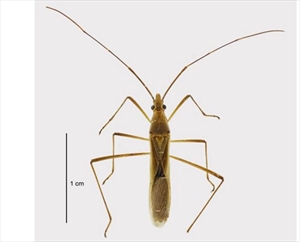Rice seed bug, rice bug, rice earhead bug
Pacific Pests, Pathogens and Weeds - Online edition
Pacific Pests, Pathogens & Weeds
Rice seed bug (299)
Leptocorisa acuta. Note, there is a related species, Leptocorisa oratorius, but research in Indonesia concluded that the loss due to the pest was minimal.
Asia, Central America, Oceania. It is recorded from Australia, American Samoa, Fiji, Federated States of Micronesia, New Caledonia, Northern Mariana Islands, Palau, Papua New Guinea, Samoa, Solomon Islands, Tonga, and Vanuatu.
Rice and grasses are the main hosts. It is also recorded on beans, breadfruit, guava, mango, millet, and more, as a minor pest.
The nymphs and adults do the damage. They spoil the seeds by sucking out their contents when they are still soft, i.e., from flowering to the dough stage. Microorganisms enter the damaged seed and cause them to dry out and discolour. Infestations of the rice bug are highest at the beginning of the rainy season.
Eggs are laid 10-20 in 2-3 rows on the upper surface of leaves, yellowish at first, later reddish-brown; they hatch producing green nymphs, similar to the adults, but wingless. The adults are about 15 mm long, brown above, whitish-green below, and narrow (Photos 1&2). The life-cycle takes about 1 month.
The bug is common on grasses, active early morning and late afternoon. High populations occur in rice fields if they have weedy areas or stands of weeds are nearby. Large populations of the rice bug also develop if there are overlapping crops. The bugs are common on both rainfed upland and lowland irrigated crops. Survival between rice crops is on weeds.
The rice seed bug is reported to be very damaging on rice in Indonesia (Java), Malaysia and the Philippines, but is not reported to be a problem in Fiji. Losses up to 30% are recorded by IRRI1. Losses are highest where crops are planted at different times, and those last harvested suffer most from the migration of bugs from crops harvested earlier.
Look for grains that are small and shriveled. Look for the eggs along the midribs of leaves, and the brown narrow nymphs and adults; when disturbed, the bugs give out an offensive smell. Monitor the crops early morning and late afternoon; at other times the insects are within the leaves or they have left the crop in search of wild grasses. Sample the plants diagonally across the field and if there are more than 10 bugs per 20 hills, spray with an insecticide.
NATURAL ENEMIES
A number of parasitoids (minute wasps) and predators have been recorded attacking larval stages.
CULTURAL CONTROL
Before planting:
- Remove weeds from within and around rice fields.
During growth:
- Plant fields at the same time in a village; synchronous planting avoids populations of the bug increasing as happens when insects move from harvested crops to younger ones.
- In small plantings, use a sweep net to capture the bugs. This is best done in the early mornings or late afternoons when the bugs are more active. At other times they are within the rice plants and difficult to catch, or they migrate temporarily to weeds.
After harvest:
- Burn the grass on the bunds and around the rice fields.
RESISTANT VARIETIES
None recommended.
CHEMICAL CONTROL
In Australia, there is nothing specifically registered for the control of the rice seed bug, but a number of insecticides registered for use on rice for other pests would provide control, such as the pyrethroid, cypermethrin, and the organophosphates, chlorpyrifos and diazinon.
____________________
When using a pesticide, always wear protective clothing and follow the instructions on the product label, such as dosage, timing of application, and pre-harvest interval. Recommendations will vary with the crop and system of cultivation. Expert advice on the most appropriate pesticide to use should always be sought from local agricultural authorities.
AUTHOR Grahame Jackson
1International Rice Research Institute, Philippines. Information from Catindig J (undated) Rice bug. Rice Knowledge Bank. IRRI. (http://www.knowledgebank.irri.org/training/fact-sheets/pest-management/insects/item/rice-bug); and from Serrano AC, et al. (2014) Featured Creatures: Rice bug. UF/IFAS, University of Florida. (http://entnemdept.ufl.edu/creatures/field/Leptocorisa_acuta.htm). Photos 1&2. Rhode BF, Crosby TK (2013) Rice Bug (Leptocorisa acuta). PaDIL - (http://www.padil.gov.au).
Produced with support from the Australian Centre for International Agricultural Research under project PC/2010/090: Strengthening integrated crop management research in the Pacific Islands in support of sustainable intensification of high-value crop production, implemented by the University of Queensland and the Secretariat of the Pacific Community.





